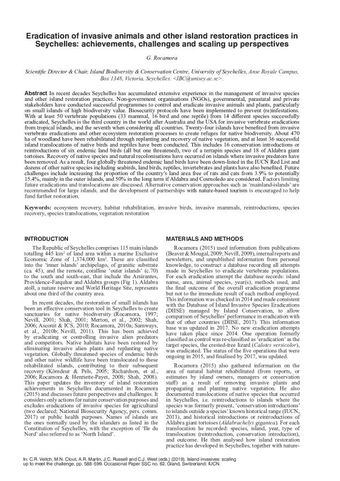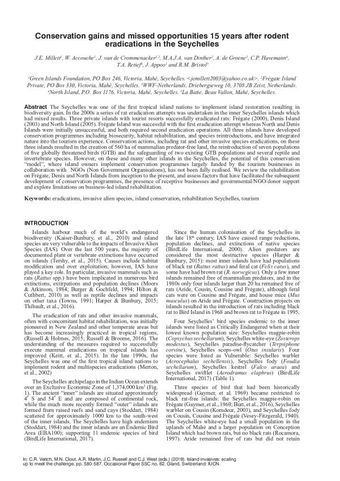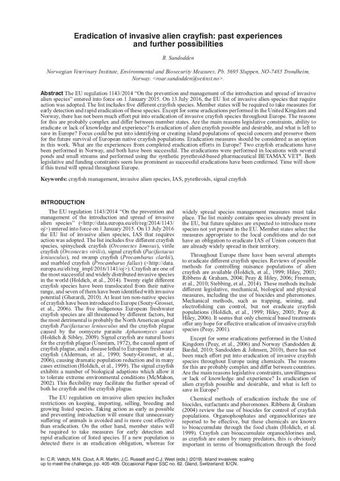Five eradications, three species, three islands: overview, insights and recommendations from invasive bird eradications in the Seychelles
- Description:
- Management and eradication techniques for invasive alien birds remain in their infancy compared to invasive mammal control methods, and there are still relatively few examples of successful avian eradications. Since 2011, five separate eradication programmes for invasive birds have been conducted on three islands by the Seychelles Islands Foundation (SIF). Target species were prioritised according to their threat level to the native biodiversity of the UNESCO World Heritage Sites of the Seychelles, Aldabra Atoll and Vallée de Mai, which SIF is responsible for managing and protecting. Red-whiskered bulbuls (Pycnonotus jocosus) and Madagascar fodies (Foudia madagascariensis) occurred on Assumption, the closest island to Aldabra, which, at the time, had no known introduced bird species. The growing population of ring-necked parakeets (Psittacula krameri) on Mahé posed a threat to endemic Seychelles black parrots (Coracopsis barklyi) on Praslin where the Vallée de Mai forms their core breeding habitat. In 2012, red-whiskered bulbuls and Madagascar fodies were detected on Aldabra, so an additional eradication was started. All eradications used a combination of mist-netting and shooting. The intensive part of each eradication lasted three years or less. On Assumption, 5,279 red-whiskered bulbuls and 3,291 Madagascar fodies were culled; on Mahé, 545 parakeets were culled; and on Aldabra 262 Madagascar fodies and one red-whiskered bulbul were culled. Each programme underwent 12 years of follow-up monitoring before eradication was confi rmed, and four of the fi ve eradications have been successful so far. None of these species had previously been eradicated in large numbers from other islands so the successes substantially advance this fi eld of invasive species management. The challenges and insights of these eradications also provide unique learning opportunities for other invasive avian eradications.
- Display date:
- 2019
- Location:
- Pacific Region
- Collections:
- Secretariat of the Pacific Regional Environment Programme (SPREP)
- Publisher:
- International Union for Nature Conservation (IUCN)
- Content partner:
- Secretariat of the Pacific Regional Environment Programme (SPREP)
- Availability:
- Not specified
-
Copyright status: All rights reservedFind out more about what you are able to do with this itemThis item is all rights reserved, with means you'll have to get permission from Secretariat of the Pacific Regional Environment Programme (SPREP) before using it. For more information, please see our use and reuse page.What can I do with this item?Non-infringing useNZ copyright law does not prevent every use of a copyright work, and this item may be hosted by an international institute or organisation. You should consider what you can and cannot do with a copyright work.No sharingYou may not copy and/or share this item with others without further permission. This includes posting it on your blog, using it in a presentation, or any other public use.No modifyingYou are not allowed to adapt or remix this item into any other works.No commercial useYou may not use this item commercially.
Related items
Welcome and warm Pasifik greetings
The information on this site has been gathered from our content partners.
The names, terms, and labels that we present on the site may contain images or voices of deceased persons and may also reflect the bias, norms, and perspective of the period of time in which they were created. We accept that these may not be appropriate today.
If you have any concerns or questions about an item, please contact us.


